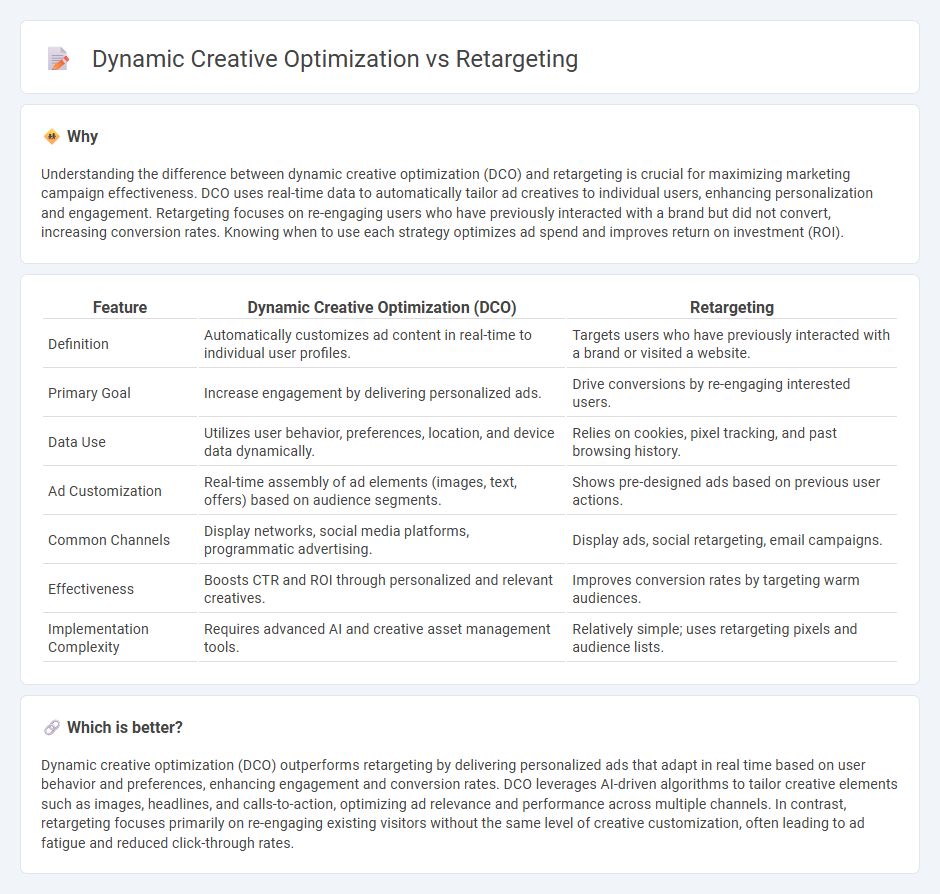
Dynamic Creative Optimization (DCO) leverages real-time data to automatically customize ad creatives for individual users, enhancing personalization and engagement. Retargeting focuses on re-engaging users who have previously interacted with a brand, driving conversions through tailored follow-up ads. Explore how combining DCO and retargeting can maximize marketing ROI and boost customer retention.
Why it is important
Understanding the difference between dynamic creative optimization (DCO) and retargeting is crucial for maximizing marketing campaign effectiveness. DCO uses real-time data to automatically tailor ad creatives to individual users, enhancing personalization and engagement. Retargeting focuses on re-engaging users who have previously interacted with a brand but did not convert, increasing conversion rates. Knowing when to use each strategy optimizes ad spend and improves return on investment (ROI).
Comparison Table
| Feature | Dynamic Creative Optimization (DCO) | Retargeting |
|---|---|---|
| Definition | Automatically customizes ad content in real-time to individual user profiles. | Targets users who have previously interacted with a brand or visited a website. |
| Primary Goal | Increase engagement by delivering personalized ads. | Drive conversions by re-engaging interested users. |
| Data Use | Utilizes user behavior, preferences, location, and device data dynamically. | Relies on cookies, pixel tracking, and past browsing history. |
| Ad Customization | Real-time assembly of ad elements (images, text, offers) based on audience segments. | Shows pre-designed ads based on previous user actions. |
| Common Channels | Display networks, social media platforms, programmatic advertising. | Display ads, social retargeting, email campaigns. |
| Effectiveness | Boosts CTR and ROI through personalized and relevant creatives. | Improves conversion rates by targeting warm audiences. |
| Implementation Complexity | Requires advanced AI and creative asset management tools. | Relatively simple; uses retargeting pixels and audience lists. |
Which is better?
Dynamic creative optimization (DCO) outperforms retargeting by delivering personalized ads that adapt in real time based on user behavior and preferences, enhancing engagement and conversion rates. DCO leverages AI-driven algorithms to tailor creative elements such as images, headlines, and calls-to-action, optimizing ad relevance and performance across multiple channels. In contrast, retargeting focuses primarily on re-engaging existing visitors without the same level of creative customization, often leading to ad fatigue and reduced click-through rates.
Connection
Dynamic creative optimization (DCO) enhances retargeting campaigns by automatically tailoring ad content based on user behavior and preferences, increasing relevance and engagement. By leveraging real-time data, DCO serves personalized ads that improve conversion rates in retargeting efforts. This synergy maximizes ROI by delivering precise messaging to users who have previously interacted with a brand.
Key Terms
Retargeting: Pixel Tracking, Audience Segmentation, Ad Placement
Retargeting leverages pixel tracking to monitor user interactions and build precise audience segments based on behavior, increasing ad relevance and conversion rates. Effective audience segmentation allows marketers to deliver tailored ads, while strategic ad placement ensures these ads reach users across multiple platforms, enhancing campaign performance. Explore advanced retargeting techniques to optimize your advertising ROI.
Dynamic Creative Optimization: Creative Variations, Real-time Personalization, Algorithmic Testing
Dynamic Creative Optimization (DCO) leverages multiple creative variations and real-time personalization to tailor ads dynamically based on user behavior and preferences, enhancing engagement and conversion rates. Algorithmic testing continuously analyzes performance data to optimize creatives on-the-fly, ensuring maximum relevance and effectiveness in campaigns. Discover how DCO transforms advertising strategies by delivering precisely targeted content that adapts instantly to audience insights.
Retargeting:
Retargeting targets users who have previously interacted with your website or ads, increasing conversion rates by delivering personalized ads based on past behavior. It effectively reduces ad spend waste by focusing on high-intent audiences, improving return on investment (ROI) for e-commerce and lead generation campaigns. Explore how retargeting strategies can enhance your digital marketing efforts and drive higher engagement.
Source and External Links
Retargeting: Definition, Types and How-tos - AdRoll - Retargeting is a digital marketing tactic using cookies and pixels to serve ads to users based on their prior interaction with a brand, aimed at re-engaging visitors who left without purchasing by displaying relevant ads across the internet.
Retargeting | Digital Advertising Glossary - Criteo - Retargeting involves various strategies such as site retargeting, search retargeting, social media retargeting, and email retargeting to serve personalized ads based on a user's past behavior with the brand to increase conversions and ROI.
What is Ad Retargeting? - Mailchimp - Retargeting helps bring back visitors who did not purchase by showing them relevant ads after they leave a website, increasing brand visibility and sales through targeted campaigns on platforms like Google Ads and Facebook.
 dowidth.com
dowidth.com